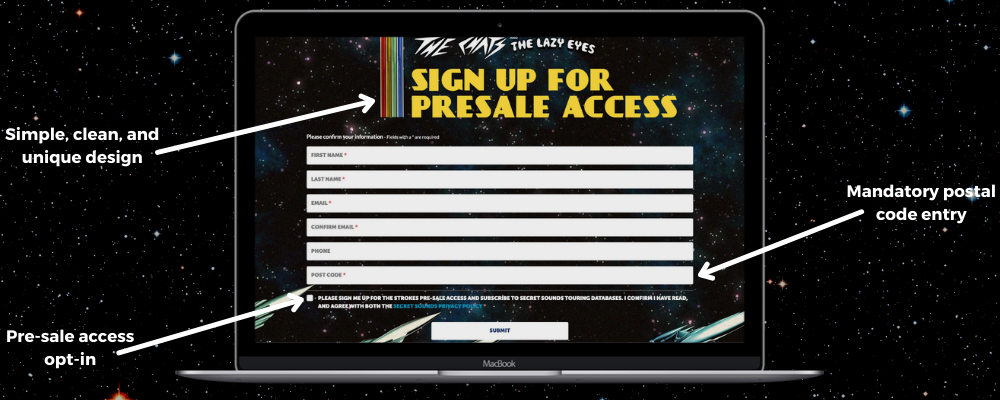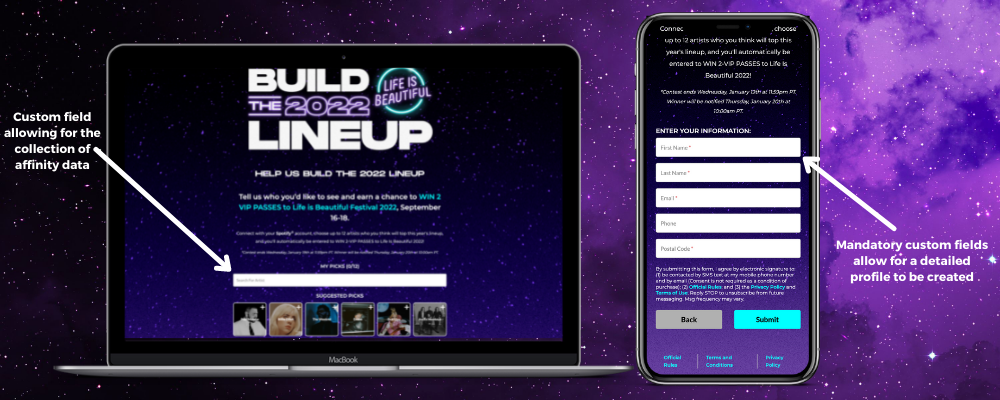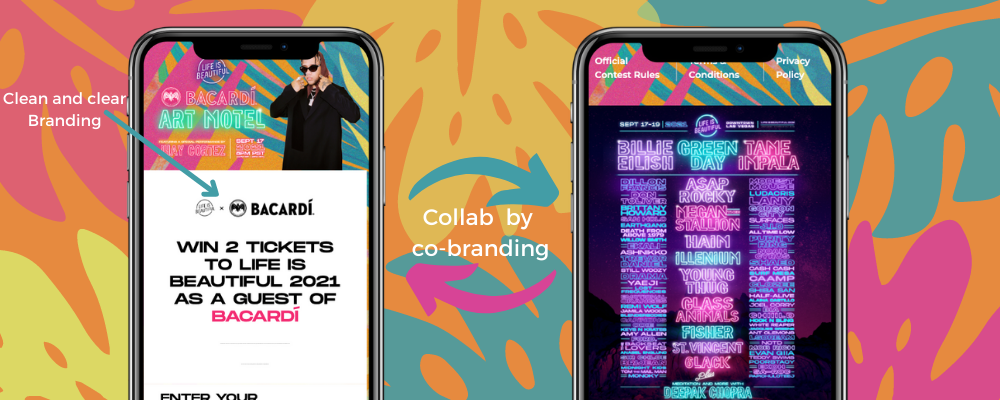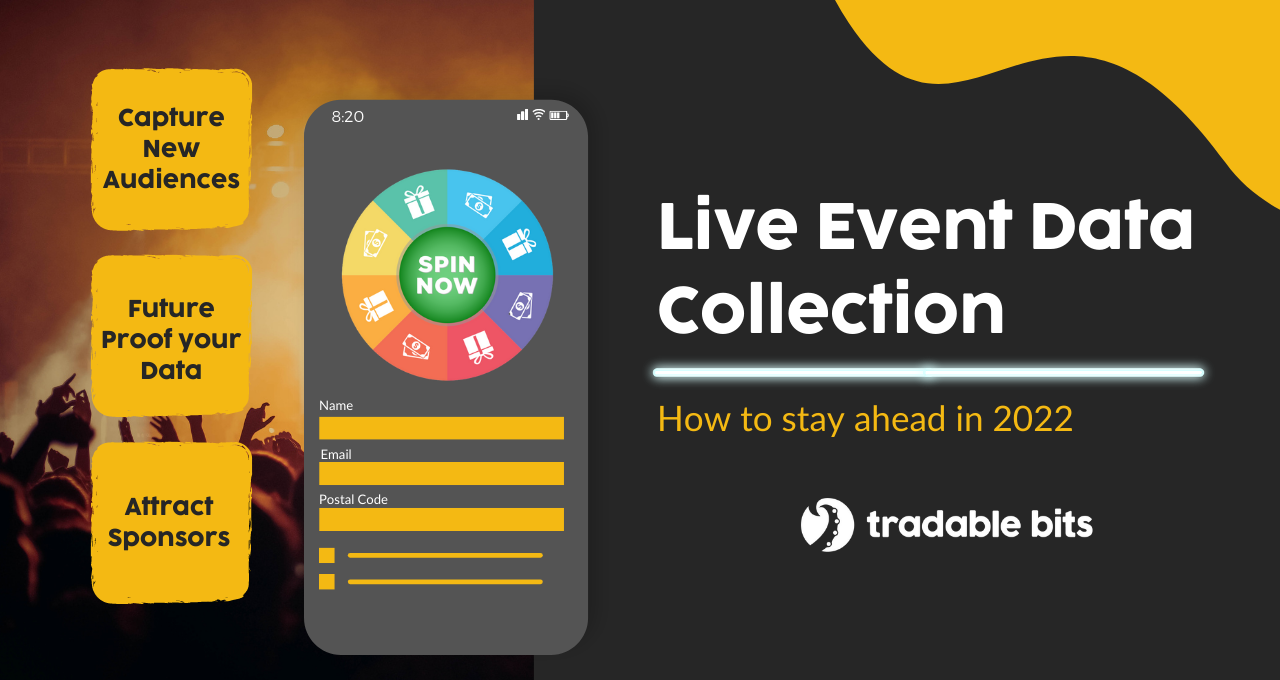How to sell out your festival year-on-year.
It’s finally time to welcome Live Events back, and we’re giddy over it. We’re also pragmatic.
While we expect a strong comeback from many festivals, there’s no denying the lasting effects of two difficult years. Most notable is the lack of data collected on fans, with many festivals reliant on audience data from 2019. We’re here for a bullish 2022 year, but we also have our eyes on the horizon for a more crowded festival arena. In this arena, first-party fan data will serve as a major competitive advantage.
With that in mind, we’ve collated a scalable strategy to help festivals continue shifting tickets and sell out year-on-year. Here are our data-collection tips for your next live event:
Priority 1: Audience Creation
In our last blog, we touched on the importance of audience creation in 2022. With the impending demise of third-party cookies and pixels fast approaching in 2023, festival-goers will be extremely difficult to reach without your first-party database. This is why it’s crucial to take advantage of a high-demand year to start collecting data on your fans.
Tip 1: Start Early, Revisit Often
As the cliché saying goes, “the best time to start was yesterday. The next best time is now.” When it comes to data, more, over longer periods often means better insights. If it seems like a large thing to bite off at this time for your team, you can build up your data collection one step at a time. But do get started.
Step 1 for you might mean integrating all of your historical ticketing data into one place, or it could be taking the time to define what benchmarks you want to build. As you start collecting data, you will see sparks of insights that drive results for your event. You will also get continuously closer to defining and reaching your best audiences.
Tip 2: Build Multiple Touchpoints Over Time
When it comes to a jam-packed festival, every stage of your festival cycle should be seen as a time to collect insights. The intention is to put data behind your fans’ journey and to profile fans as they move through your funnel. This will allow you to create fully-formed profiles of new and existing faces for personalized communication down the line. You’ll be a step ahead of your competition if you can cut through the noise to speak directly to your fans wherever you interact with them - whether it’s through channels like email & SMS, or ads.
Some examples of ways to collect data over different stages of your festival include pre-registration forms, giveaways, surveys, and other contests that link in some way to lead gen forms. Get creative!
Priority 2: Positioning & Measuring ROI
Tip 1: Deliberately define your "best fans"
Beyond your headliners, positioning is what sets your fest apart in a saturated market. To get this right you need to understand the true alternatives for fans in your region, and how your unique attributes differentiate you. This starts with understanding who your best fans are, and why they love you.
Go much deeper than “Zillenial Influencer” when it comes to defining your key fans. Where do they engage with you? How do they behave? What do they love the most about your festival, and why do they keep coming back year after year? Now that you have your first-party data built out, you can start defining answers to these questions. Instead of spending money on throwing too large a net, you can effectively position your festival for your best fans and people like them.
Tip 2: Measure ROI over a longer term
We’ve all heard of OKRs, and return on investment is one part of measuring your success. At face value quantifying return on investment can be as simple as seeing if your ticket sales outperform your costs. However with so many different variables affecting your ROI, determining what is responsible for the shift in revenue is not so easy. This is where longer-term data comes into play. Having a database that stretches over multiple events gives a clearer picture of what is and isn’t working.
Priority 3: Getting Sponsors Involved
Sponsorship can be a great way to back your festival financially while creating a brand partnership that lets you tap into new spheres. And what we love about sponsorship today is that they’re becoming more and more strategic.
Equipping your festival with fan data (and the ability to collect and analyze more) can be a fundamental tool in attracting new types of sponsorships. Not only can you collect lead-gen data for sponsors, but you can also showcase the success of an event. Say your sponsor is on the ground sampling. Simple first-party data tools let them know who was interested in their offerings, and what they ended up coming back for. In a world fuelled with data, finding a more reliable way to quantify success for your sponsors will give you an edge.
A 3-Step Playbook to Getting Started with Data
Similar to a live event, a great deal of planning should go into preparing a data collection strategy. Having a clear understanding of your database and any gaps within it will help inform your data collection objective. However, the rapidly changing nature of this industry also necessitates consistent data collection over time.
1. Early Bird gets the Worm
Let your data work for you earlier on. By implementing early bird promotions like pre-sales or pre-registration campaigns, you gain data on low-cost, high-value fans that you can reach out to directly when your tickets drop. And, by planning this out early, you can orchestrate a sense of urgency among fans. The best part yet? You can also use these early bird promotions to collect more opt-ins to email, SMS or your other comms, where you can influence more fans to purchase.
A great example of a stunning pre-registration form comes from Secret Sounds. Not only is this pre-reg form visually striking (absolutely knocks it out with setting a sense of ‘cool’) but it effectively captures strong lead data as well. Information like postal codes is huge when it comes to targeted ads down the line

2. Involve your Fans & Listen
To continuously improve your festival, placing value on what your festival attendees have to say is a good place to start. Often, the key to maintaining the right balance between offering innovative experiences to your fans and sticking to your roots is by listening and asking the right questions.
For example, if your objective is to collect affinity data from your fans to better inform your booking team, a fun campaign coupled with custom fields could help reveal this information. Asking fans to try to share their dream lineup of your festival is just one example. To increase the reach and completion rate of these campaigns, you can always add an incentive, and put money behind the campaign’s promotion.
Life is Beautiful, one of the world's highest-grossing music festivals, saw a 98% opt-in using this exact approach, with over 25% of entrants being new fans. With a well thought out campaign, they uncovered new fan insights to refine both their upcoming festival and those in the future.

3. Keep it Consistent
Keeping consistent branding throughout your campaigns as you accumulate your first-party data is key. Prioritizing simplicity and mobile accessibility within your design will promote opt-ins even further. And, when you take the time at the beginning to lay out design guidelines for your team, you can easily template your work later on.
Campaign branding also gives you the opportunity to provide more value to sponsors through co-branded campaigns where data can be captured for both parties.
Life is Beautiful did exactly that with their entry form with Bacardi. The co-branded campaign promoted both parties on a mobile-friendly medium that gets straight to the point

Bringing it All Together
To put it simply, 2023 will leave behind the festivals that have not prioritized their first-party data collection and audience creation efforts in the years prior. This makes the opportunity cost of not collecting fan data today, high. And with all the additional benefits mentioned, why not get creative with some data capture strategies this year?
Key Takeaways
- You should collect data even in a year where you expect to sell out
- Taking advantage of fan data before, during and after a live event will:
- Future proof your database
- Refine your Audience
- Give you more insight on measurement
- Attract sponsors
